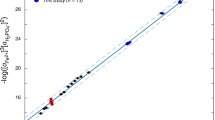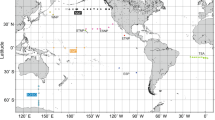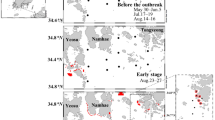Abstract
THE biologically labile fraction of the dissolved organic matter (DOM) in the oceans seems to be a chemically complex solution of a wide variety of compounds derived mainly from the contents of cellular metabolic pools released into the seawater after the death and cell lysis of marine organisms. This fraction is of particular geochemical interest because of its importance in understanding the cycling of organic matter in the marine environment. Because of methodological problems arising from the extremely low concentrations of individual compounds, compound-specific analyses have been limited to only a few components of the DOM, such as ammo acids1, lipids2, sugars5, and vitamins3. Adenosine-5′-triphosphate (ATP) would be a useful tracer for following the production and fate of labile DOM in seawater as it is a universal component of the cellular metabolic pools of all living organisms. We report here that dissolved ATP (DATP) occurs in seawater in significant concentrations (0.1–0.6 µg 1−1) and is utilised rapidly by marine bacteria.
This is a preview of subscription content, access via your institution
Access options
Subscribe to this journal
Receive 51 print issues and online access
$199.00 per year
only $3.90 per issue
Buy this article
- Purchase on Springer Link
- Instant access to full article PDF
Prices may be subject to local taxes which are calculated during checkout
Similar content being viewed by others
References
Lee, C. & Bada, J. L. Earth planet. Sci. Lett. 26, 61–68 (1975).
Williams, P. M. J. Fish. Res. Bd Can. 22, 1107–1122 (1965).
Provasoli, L. & Carlucci, A. F. in Algal Physiology and Biochemistry (ed. W. D. P. Stewart) 741–789 (Blackwell Scientific, Oxford, 1974).
Holm-Hansen, O., in Estuarine Microbial Ecology (ed. H. Stevenson & R. R. Colwell) 73–89 (University of South Carolina Press, Columbia, South Carolina, 1973).
Vaccaro, R. F., Hicks, S. E., Jannasch, H. W. & Carey, F. G. Limnol. Oceanogr. 13, 356–360 (1968).
Hodson, R. E., Holm-Hansen, O. & Azam, F. Mar. Biol. 34, 143–149 (1976).
Hulett, H. R. Nature 225, 1248–1249 (1970).
Azam, F. & Hodson, R. E. Limnol. Oceanogr. 22, 492–501 (1977).
Cited in the discussion of: Hodson, R. E., Holm-Hansen, O. & Azam, F. in ATP Methodology Seminar (ed. Borun, G. A.) 394–425 (SAI Technology Company, San Diego, California, 1975).
Author information
Authors and Affiliations
Rights and permissions
About this article
Cite this article
AZAM, F., HODSON, R. Dissolved ATP in the sea and its utilisation by marine bacteria. Nature 267, 696–698 (1977). https://doi.org/10.1038/267696a0
Received:
Accepted:
Published:
Issue Date:
DOI: https://doi.org/10.1038/267696a0
This article is cited by
-
A novel method: using an adenosine triphosphate (ATP) luminescence–based assay to rapidly assess the biological stability of drinking water
Applied Microbiology and Biotechnology (2019)
-
Single-cell imaging of phosphorus uptake shows that key harmful algae rely on different phosphorus sources for growth
Scientific Reports (2018)
-
Growth responses of Ulva prolifera to inorganic and organic nutrients: Implications for macroalgal blooms in the southern Yellow Sea, China
Scientific Reports (2016)
-
Seasonal nutrient fluxes variability of northern salt marshes: examples from the lower St. Lawrence Estuary
Wetlands Ecology and Management (2009)
-
Mechanisms of pain in angina pectoris?A critical review of the adenosine hypothesis
Cardiovascular Drugs and Therapy (1993)
Comments
By submitting a comment you agree to abide by our Terms and Community Guidelines. If you find something abusive or that does not comply with our terms or guidelines please flag it as inappropriate.



